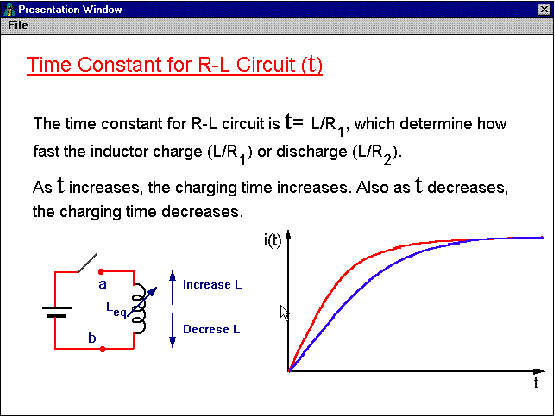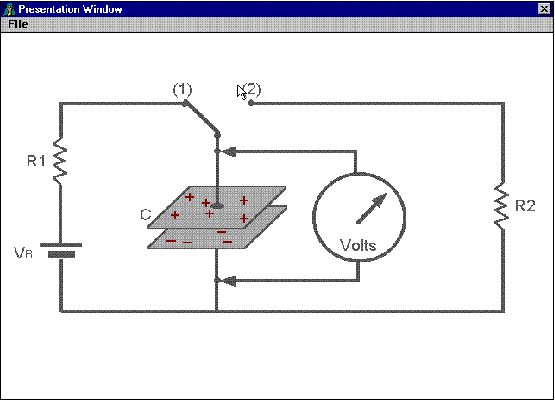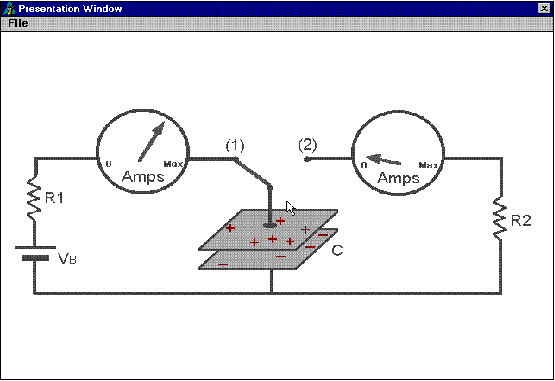
Figure (1) up
DEVELOPMENT OF A COMPUTER-BASED
INSTRUCTION
IN TRANSIENT ANALYSIS
The fast growing computers' technology is affecting most aspects of our life from airline reservation to education. Education is the key to produce more at a lower cost with a higher quality. However, there are difficulties associated with traditional classroom education such as traveling distance between work and university, and interruption of work schedule. Computer-Based Instruction (CBI) integrates a combination of on-screen text, images, voice, movies and sound effects in one package and delivering it for the students as a main source of instructions.
In this paper, we discuss the Development of a Computer-Based Instruction in Transient Circuit Analysis using Authorware 3.0. Authorware is an object-oriented programming package that supports the incorporation of text, graphics, animation, audio and video. It was selected by Greenfield Coalition as the authoring tool for building courseware to be delivered to Focus: HOPE's candidates.
Educational research has shown over the last decade that traditional classroom teaching is ineffective. Students learn how to manipulate equations to solve problems, but leave the courses without an understanding of basic physical concepts [1]. Other difficulties associated with traditional classroom system are traveling distance between work place and university, interruption of work schedules, and difficulty presenting the latest information and technology. As a result, the American industry has initiated cooperation with colleges and universities to build "modular" educational courseware elements that will train employees and thus increase the company's competitive edge.
A Computer-Based Instruction (CBI) is instructors' and learners' dream come true. Combining text, sound, graphics and motion in creating instructional materials, educational applications, classroom training and job aids help students to understand the main concepts and enable learners to do far more than read or listen [2]. Using multimedia tools in CBI helps in holding the students' attention, encouraging involvement, and demonstrating technical concepts much more effectively [3].
GREENFIELD COALITION
The Greenfield Coalition for New Manufacturing Education is a National Science Foundation supported partnership of six diverse educational institutions, five top manufacturing companies, an international member-based educational society and an operational manufacturing/teaching enterprise. Greenfield is a new model for manufacturing education based on the combination of skill and deep engineering knowledge resulting from an integration of engineering practice and innovative pedagogy. The coalition is creating next generation courseware designed to integrate training issues with educational foundations. This is being accomplished by combining theory and practice in an interdisciplinary, team-oriented environment anchored to a "real world" production floor--the first delivery site, Focus: HOPE's "Center for Advanced Technologies". The Greenfield courses are designed to be modular in nature, and thus offer an ideal educational environment for multimedia-based CBI delivery.
Focus:HOPE is a civil and human rights organization founded in 1968 by Fr. William T. Cunningham and Eleanor M. Josaitis. Focus:HOPE unites a multicultural community in common efforts to overcome injustice and build racial harmony. Originally an interracial movement of volunteers, focus:Hope today employs around 850 persons and involves 45,000 supporters. Over the years Focus:HOPE has initiated practical solutions to the problems of hunger, economic disparity, inadequate education, and racial divisiveness.
BENEFITS OF CBI DEVELOPMENT
By using CBI, students can study the materials at their own pace with no need to travel or interrupt work schedules. The students can repeat a topic as much as needed until they understand the concept, where in a regular classroom, a student might feel embarrassed of asking the instructor to repeat the explanation of difficult points. The use of animated pictures, digital movies, voice and sound effects inside CBI modules attracts the attention of students and enables learners to extend and enhance their skills and working knowledge at a time, pace and place to suit them as individuals and/or teams [4].
CBI will not replace instructors. However, the instructor's role will be changed from lecturing to coaching. Instead of repeating the same information for each class in every semester, instructors will spend more time on updating the CBI modules and bringing more real-world case studies to it.
CBI development initially requires a large investment. However, this cost is typically absorbed in a couple of years. For example Anderson Consulting has developed a Computer Based Training (CBT) course using both Macromedia's Authorware Professional and Asymetrix Multimedia Toolbook [5]. The cost of developing a CBI module is independent of the number of students using it, while in a regular class room the overall cost may increase as the numbers of students increase. The fact that CBI modules can be published in the World Wide Web (WWW) and therefore be accessible to an enormous number of students helps in off setting the cost of development, delivery and upgrades.
An authoring package is a tool that has pre-programmed elements for interactive multimedia developments and allows the integration of text, images, sound and motion [6]. Greenfield Coalition has selected Authorware as the authoring tool for building the modules needed to be delivered to Focus: HOPE's candidates. Authorware is an object-oriented programming package that supports the incorporation of text, graphics, animation, audio and video. It has pre-programmed elements built in it for interactive multimedia developments which take less time to build an application than high level programming languages. Authorware also has an Iconic/Flow control diagram that shows the links between elements and icons, which may represent different functions and interactions of sound, bottoms, movies, etc.
Macromedia's Authorware Professional has the following features:
During CBI development, we have faced few difficulties that we outlined below:
TRANSIENT ANALYSIS MODULE
The module is divided into four main topics:
(1) The natural response of RL
(2) The natural response of RC
(3) The RLC circuit
(4) Analogy
Every topic starts with the instructional material with embedded examples. At the end of each topic, there are more examples, where students have chance to work on, a summary and a quiz. If the student is not ready, he or she can delay taking the quiz.
In the natural response of RL circuit, we discuss how an inductor behaves as a closed circuit and as an open circuit. Then, we show the mathematical analysis of RL circuits for both transient and steady state cases. The time constant (t) of this circuit and its effect on both charging and discharging cases has been discussed.
In the second topic, the natural response of RC circuit, the transient and the steady state of an RC circuit has been discussed. Then the mathematical analysis of an RC circuit and the time constant (t) and its effect for both large and small RC circuits has been discussed.
To evaluate the response for RLC circuit, we derive the second-order homogenous differential equation for the circuit. The analysis is based on the roots of the characteristic equation that could be real and distinct, complex, or repeated. We animate the response based on each of these cases to show the effect of underdamped, overdamped and critically damped responses.
An analogous between electrical and mechanical systems and elements is introduced in the last topic "Analogy". Analogous circuits represent systems for which the mathematical equations have the same form. The corresponding variables and parameters in two circuits represented by equations of the same form are called analogous. For example a mechanical system can be represented by an equivalent electrical system which has the same mathematical representation.
During CBI development, we have included many nice features such as hot words, digitized sounds, pictures and animation. These features have been used interactively in introducing the materials of the module. Other features such as glossary and calculator programs were also added so that the students can use them whenever needed. In order to understand their effect on the circuit behavior and response, the students can control few circuit parameters such as time constant(t), charging and discharging. Figure (1) shows the circuit in which the student can increase or decrease the time constant(t) and its effect on charging. Figures (2) and (3) show the circuit in which the student can switch to charging (1) or discharging (2) of a capacitor and watch the corresponding changes in voltages and currents respectively.

Figure (1) up

Figure (2) up

Figure (3) up
At the end of every topic, there are summery, examples and quizzes. Quizzes are selected from a bank randomly. There are at least 4 questions for every topic selected from a set of more than 20 questions. In the first delivery, the students can take the quizzes as many times as needed. As a result, students took the quizzes as many times as needed to get a perfect score (100%). Therefore, we decided to change that and limit it to two times only. A record of the students' grades and progress in the module is being saved for each topic. The quizzes are interfaced with the login procedure to keep track of students' progress in terms of topic completion and grade. The login procedure allows us to restrict the access to the CBI module. The login procedure has many powerful features. Students have the ability to browse their own records or change their passwords, while the instructor has the ability to access the record of all students. The record includes quiz grades and topics completed by students. We are working to export students' records to spreadsheet such as Excel, which we can use for statistical analysis.
CONCLUSION
The Transient Circuit Analysis module has been developed as Computer-Based Instruction using Authorware 3.0 as the authoring tool. It's the fifth module that has been developed at the Electrical Engineering and Physics department. In order to make this CBI module more flexible, we are working on interfacing it with other programs such as Pspice and MATLAB. Case studies such as car ignition system with animation will be integrated into the module to be intuitive and easy to understand. We are planning to offer it to Focus: HOPE's candidates next year.
REFERENCES